Two Geophysical Technologies Used in Archaeological Research Simplified and Explained
Definition
1. Introduction
2. GPR and ERT Methods
2.1. Instrumentation
2.1.1. Ground Penetrating Radar (GPR) Systems
- Sensors and Software Inc., located in Mississauga, Ontario, Canada, is a recognized worldwide company that designs and manufacturers GPR instrumentation and software for numerous applications that include locating buried utilities, and numerous engineering applications like concrete scanning, structural assessment, mining, and quarrying. Their systems are also used in forensics, geology, geotechnical and environmental assessment, glaciology, agriculture, unexploded ordnance (UXO) detection, and archaeology [13]. The methodology associated with using a Sensors and Software pulseEKKO™ system, as part of an archaeological study, is outlined in Appenidx A, of this entry, because this system was used to collect GPR data in the examples provided in this entry.
- Geophysical Survey Systems, Inc. located in Nashua, NH, USA, designs and builds GPR tools that are used in engineering applications like checking the structural health of roads, bridges, and skyscrapers. Additionally, their systems are used for locating buried utilities; hydrogeological investigations; geological investigations and mapping; forensics applications like evidence and clandestine grave location; archaeological excavation planning; cemetery mapping; and cultural resource management [14].
- Guideline Geo, whose global headquarters are located in Stockholm, Sweden, is a global geophysics and geotechnology company that offers GPR sensors, software, services, and support needed to map and visualize the subsurface. It provides complete solutions and applications in four key growth areas, which include detecting and mapping groundwater; environmental and geological risk assessments; infrastructural site investigations; and mineral exploration. Guideline Geo acquired MALÅ Imaging Radar Array (MIRA) systems, which was originally located in Malå, Sweden, which is a technically advanced one-pass 3D GPR system for large-scale mapping and subsurface object identification [15].
2.1.2. Electrical Resistivity Tomography (ERT) Systems
- Guideline Geo, as noted above, is a geotechnology company that offers sensors, software, services, and support to map and visualize the subsurface using GPR and ERT. In the 1990’s they acquired the Swedish company ABEM (Aktiebolaget Elektrisk Malmletning), which is a pioneer in geophysical solutions for resource and infrastructural development using resistivity, induced polarization, electromagnetics, and seismic studies. Areas of emphasis for this instrumentation include groundwater mapping, mineral exploration, and engineering and infrastructure site investigations [16]. The methodology associated with using an ABEM Terrameter LS system, as part of an archaeological study, is part of Appendix B, of this entry because, this system was used to collect ERT data in the examples provided in this entry.
- Advanced Geoscience Incorporated (AGI), located in Austin, TX USA, is the leading developer and manufacturer of electrical resistivity, induced polarization (IP), and self-potential (SP) systems used to explore the subsurface, primarily by measuring the electrical properties of the earth’s materials. Resistivity measures the resistance of the ground to electrical current, while IP and SP measure the electrical response of the ground to applied or natural electrical fields. AGI ERT systems are used for siting groundwater wells, monitoring groundwater pollution plumes, finding caves and sinkholes, monitoring landslides, finding economic minerals, and exploring archaeological sites [17].
- Zonge International, located in Reno, NV USA, provides geophysical equipment to geoscientists worldwide for use in exploration, environmental, and geotechnical surveys. Both resistivity (ERT) and induced polarization (IP) geophysical survey methods are used to reveal variations in, for example, fluid saturation, fluid resistivity, rock type, porosity, and permeability. This data can be used to delineate aggregate deposits for quarries, estimate depth to bedrock and the water table, detect and map geologic features, and define mining and archaeological targets [18].
2.2. Collection of GPR Data
GPR Data Collection System and Results
2.3. Collection of ERT Data
ERT Data Collection System and Results
2.4. Description and Explanation of GPR and ERT Methodologies
3. Explanation of Terms and Concepts
3.1. GPR Methodology Simplified and Explained
3.2. ERT Methodology Simplified and Explained
4. Summary, Conclusions, and Prospects
Funding
Institutional Review Board Statement
Informed Consent Statement
Data Availability Statement
Acknowledgments
Conflicts of Interest
Appendix A. GPR Methodology
Appendix B. ERT Methodology
References
- Geological Society of America (GSA). Geophysics Overview. Center for Professional Excellence. 2025. Available online: https://careers.geosociety.org/career/geophysicist (accessed on 26 March 2025).
- Sarris, A.; Kalayci, T.; Moffat, I.; Manataki, M. An Introduction to Geophysical and Geochemical Methods in Digital Geoarchaeology. In Digital Geoarchaeology, Natural Science in Archaeology; Siart, C., Forbriger, M., Bumboozer, O., Eds.; Springer: Cham, Switzerland, 2018. [Google Scholar] [CrossRef]
- Guarinello, N. Archaeology and the Meanings of Material Culture. In Global Archaeological Theory; Springer: Boston, MA, USA, 2006; pp. 19–27. [Google Scholar] [CrossRef]
- Salisbury, R.; Bull, I.; Cereda, S.; Draganits, E.; Dulias, K.; Kowarik, K.; Meyer, M.; Zavala, E.; Salisbury, K. Making the Most of Soils in Archaeology. A Review. Archaeol. Austriaca 2022, 106, 319–334. [Google Scholar] [CrossRef]
- Huddleston, J.; Kling, G. Manual for Judging Oregon Soils; Extension Service 1996; Oregon State University: Corvallis, OR, USA, 1996; 102p, Available online: https://ir.library.oregonstate.edu/concern/open_educational_resources/3197xm437 (accessed on 20 April 2025).
- Capozzoli, L.; Giampaolo, G.; DeMartino, G.; Perciante, F.; Lapenna, V.; Rizzo, E. ERT and GPR Prospecting Applied to Unsaturated and Subwater Analogue Archaeological Site in a Full-Scale Laboratory. Appl. Sci. 2022, 12, 1126. [Google Scholar] [CrossRef]
- Kirch, P. Archaeology and Global Time Change: The Holocene Record. Annu. Rev. Environ. Resour. 2005, 30, 409–440. [Google Scholar] [CrossRef]
- Deiana, R.; Leucci, G.; Martorana, R. New Perspectives on Geophysics for Archaeology: A Special Issue. Surv. Geophys. 2018, 39, 1035–1038. [Google Scholar] [CrossRef]
- De Giorgi, L.; Leucci, G. The archaeological site of Sagalassos (Turkey): Exploring the mysteries of the invisible layers using geophysical methods. Explor. Geophys. 2018, 49, 751–761. [Google Scholar] [CrossRef]
- Landeschi, G. Rethinking GIS, three-dimensionality, and space perception in archaeology. World Archaeol. 2019, 51, 17–32. [Google Scholar] [CrossRef]
- Banning, E. Archaeological Spatial Analysis; Gillings, M., Hacıgüzeller, P., Lock, G., Eds.; Routledge: London, UK, 2020; Chapter 2; 24p. [Google Scholar] [CrossRef]
- State Historic Preservation Office: Ohio History Connection, Archaeology Guidelines Supplement for Geophysical Survey. 2022. 47p. Available online: https://www.ohiohistory.org/wp-content/uploads/2022/12/Archaeology_Guidelines_Supplement_Geophysical_Survey.pdf (accessed on 20 April 2025).
- Sensors and Software: From Radiodetection. Ground Penetrating Radar (GPR) Solutions 2025. Available online: https://www.sensoft.ca/ (accessed on 23 April 2025).
- Geophysical Survey Systems, World Leader in Ground Penetrating Radar (GPR). 2025. Available online: https://www.geophysical.com/about-gssi (accessed on 25 April 2025).
- Guideline Geo, MALÅ GPR Systems. 2025. Available online: https://www.guidelinegeo.com/mala-ground-penetrating-radar-gpr/ (accessed on 25 April 2025).
- Guideline Geo, ABEM Geophysical Solutions. 2025. Available online: https://www.guidelinegeo.com/abem-resistivity-seismics-tem/ (accessed on 28 April 2025).
- Advanced Geoscience Incorporated (AGI), Electrical Resistivity Imaging Instruments. 2025. Available online: https://www.agiusa.com/ (accessed on 25 April 2025).
- Zonge International, Electrical & Electromagnetic Geophysical Survey Methods. 2025. Available online: http://zonge.com/geophysical-methods/electrical-em/ (accessed on 1 May 2025).
- Malagodi, S.; Orlando, L.; Piro, S.; Rosso, F. Location of Archaeological Structures using GPR Method: Three-dimensional Data Acquisition and Radar Signal Processing. Archaeol. Prospect. 1996, 3, 13–23. [Google Scholar] [CrossRef]
- Reeder, P.; Jol, H.; McClymont, A.; Bauman, P.; Daubaras, M. Interconnected Histories: Searching for Jacob Gens’ Grave and Instead Finding a Forgotten Early 18th Century Cemetery. Histories 2025, 5, 17. [Google Scholar] [CrossRef]
- CLU-IN, Characterization Technology Guides, Geophysical Methods: Electrical Resistivity Tomography, 2025. Available online: https://clu-in.org/characterization/technologies/default2.focus/sec/Geophysical_Methods/cat/Electrical_Resistivity_Tomography/ (accessed on 10 May 2025).
- Harikumar, R.; Prabu, R.; Raghavan, S. Electrical Impedance Tomography (EIT) and Its Medical Applications: A Review. Int. J. Soft Comput. Eng. (IJSCE) 2013, 3, 193–198. [Google Scholar]
- Benson, R.; Glaccum, R. Geophysical Techniques for Sensing Buried Wastes and Waste Mitigation. Lockheed Engineering and Management Services, Environmental Monitoring Systems Lab, U.S. Department of Commerce, National Technical Information Service 1984, 256p. Available online: https://nepis.epa.gov/Exe/tiff2png.cgi/P1007SIO.PNG?-r+75+-g+7+D%3A%5CZYFILES%5CINDEX%20DATA%5C81THRU85%5CTIFF%5C00001925%5CP1007SIO.TIF (accessed on 10 May 2025).
- Atekwana, E.; Atekwana, E. Geophysical Signatures of Microbial Activity at Hydrocarbon Contaminated Sites: A Review. Surv. Geophys. 2009, 31, 247–283. [Google Scholar] [CrossRef]
- Reci, H.; Jata, I.; Bushati, S. ERT Method for the Detection of Buried Archaeological Objects in Apollonia and Bylis, Albania. Rom. Rep. Phys. 2015, 67, 665–672. [Google Scholar]
- Negri, S.; Leucci, G.; Mazzone, F. High resolution 3D ERT to help GPR data interpretation for researching archaeological items in a geologically complex subsurface. J. Appl. Geophys. 2008, 65, 111–120. [Google Scholar] [CrossRef]
- Deiana, R.; Bonetto, J.; Mazzariol, A. Integrated Electrical Resistivity Tomography and Ground Penetrating Radar Measurements Applied to Tomb Detection. Surv. Geophys. 2018, 39, 1081–1105. [Google Scholar] [CrossRef]
- Puspita, M.; Suyanto, I. Investigation of groundwater aquifer at Noborejo, Salatiga using Electrical Resistivity Tomography (ERT) and Vertical Electrical Sounding (VES) methods. In International Conference on Innovation and Technology, IOP Conference: Earth and Environmental Science; IOP Publishing: Bristol, UK, 2020; Volume 524, p. 012009. [Google Scholar] [CrossRef]
- Reeder, P.; Jol, H.; Freund, R.; McClymont, A.; Bauman, P.; Šmigelskas, R. Investigations at the Heereskraftfahrpark (HKP) 562 Forced-Labor Camp in Vilnius, Lithuania. Heritage 2023, 6, 466–482. [Google Scholar] [CrossRef]
- Day-Lewis, F.; Johnson, C.; Singha, K.; Lane, J., Jr. Best Practices in Electrical Resistivity Imaging: Data Collection and Processing, and Application to Data from Corinna, Maine. An Administrative Report for EPA Region 1. 227p. Available online: https://clu-in.org/programs/21m2/projects/EPA_admin_report_02Dec2008_final.pdf (accessed on 10 May 2025).
- Papadopoulos, N.; Tsourlos, P.; Tsokas, G.; Sarris, A. Efficient ERT measuring and inversion strategies for 3D imaging of buried antiquities. Near Surf. Geophys. 2007, 5, 349–361. [Google Scholar] [CrossRef]
- Interstate Technology and Regulatory Council (ITRC), Implementing Advanced Site Characterization Tools. ASCT-1. Washington, DC; 2019. Available online: https://asct-1.itrcweb.org/5-surface-geophysics/?print=pdf (accessed on 9 May 2025).
- RES2DINV (Version 5.0), Rapid 2-D Resistivity & IP Inversion. Geotomo Software, 2025. Available online: https://ags-cloud.dk/AGS/Geotomo%20Manuals/Res2DInv_Manual.pdf (accessed on 11 May 2025).
- Lu, D.; Wang, F.; Chen, X.; Ou, J.; Wang, H. An Improved ERT Approach for the Investigation of Subsurface Structures. Pure Appl. Geophys. 2017, 174, 375–386. [Google Scholar] [CrossRef]
- Diallo, M.; Cheng, L.; Rosa, E.; Gunther, C.; Chouteau, M. Integrated GPR and ERT data interpretation for bedrock identification at Cléricy, Québec, Canada. Eng. Geol. 2019, 248, 230–241. [Google Scholar] [CrossRef]
- Jia, W.; Wang, S.; Min, S.; Zhang, Y. Electromagnetic energy focusing technology with GPR array transmitting antenna for high resolution detection. Measurement 2022, 203, 112000. [Google Scholar] [CrossRef]
- Bernabini, M.; Pettinelli, E.; Pierdicca, N.; Piro, S.; Versino, L. Field experiments for characterization of GPR antenna and pulse propagation. J. Appl. Geophys. 1995, 33, 63–76. [Google Scholar] [CrossRef]
- EPA: United States Environmental Protection Administration. Ground Penetrating Radar (GPR): Basic Concept. Available online: https://www.epa.gov/environmental-geophysics/ground-penetrating-radar-gpr (accessed on 20 May 2025).
- Zhang, C.; Gravey, M.; Mariéthoz, G.; Irving, J. Reconstruction of High-Resolution 3D GPR Data from 2D Profiles: A Multiple-Point Statistical Approach. Remote Sens. 2024, 16, 2084. [Google Scholar] [CrossRef]
- Bano, M.; Economou, N.; Bradford, J.; Giannopoulos, A.; Klotzsche, A.; Slob, E.; Tsoflias, G. GPR data imaging and interpretation—Introduction. Geophysics 2022, 87, WBi–WBii. [Google Scholar] [CrossRef]
- Bristow, C.S.; Jol, H.M. An Introduction to Ground Penetrating Radar (GPR) in Sediments, GPR in sediments: Advice on data collection, basic processing and interpretation, a good practice guide. In Geological Society; Special Publications: London, UK, 2003; Volume 211, pp. 9–27. [Google Scholar]
- Junoh, M.; Sulaiman, S.; Razali, M.; Rashid, N.; Mahmood, M.; Satirapod, C. Utilizing of 500 MHz Ground Penetrating Radar Antenna Coupling at Different Interval Heights Clearance. IOP Conference Series: Earth and Environmental Science, 1217. In Proceedings of the 6th International Conference on Research Methodology for Built Environment and Engineering, Bangkok, Thailand, 28 February–2 March 2023; pp. 1–15. [Google Scholar] [CrossRef]
- Quang-Huy, T.; Sharma, B.; Theu, L.; Tran, D.; Chowdhury, S.; Karthik, C.; Guruswamy, S. Frequency-hopping along with resolution-turning for fast and enhanced reconstruction in ultrasound tomography. Sci. Rep. 2024, 14, 15483. [Google Scholar] [CrossRef]
- Sensors and Software from Radiodetection. Field Guide for Archeologists Using GPR. Available online: https://www.sensoft.ca/wp-content/uploads/2021/10/Field-Guide-for-Archaeologist-Using-GPR-FinalV2.pdf (accessed on 20 May 2025).
- McClymont, A.F.; Bauman, P.D.; Freund, R.A.; Seligman, J.; Jol, H.M.; Reeder, P.; Bensimon, K.; Vengalis, R. Preserving Holocaust history: Geophysical investigations at the Ponary (Paneriai) extermination site. Geophysics 2021, 87, 15–25. [Google Scholar] [CrossRef]
- McClymont, A.; Konik, J.; Jol, H.; Bauman, P.; Miazga, C.; Reeder, P. 3D characterization of the Mila 18 archaeological site in Warsaw, Poland: From imaging to excavation. Lead. Edge 2024, 43, 657–664. [Google Scholar] [CrossRef]
- Reeder, P.; Jol, H.; McClymont, A.; Bauman, P.; Barrow, M. Using Geophysics to Locate Holocaust Era Mass Graves in Jewish Cemeteries: Examples from Latvia and Lithuania. Heritage 2024, 7, 3766–3798. [Google Scholar] [CrossRef]
- Sensors and Software from Radiodetection. Glossary of GPR Terms. Antenna Separation. Available online: https://www.sensoft.ca/resources/glossary-of-gpr-terms-2-2/ (accessed on 20 May 2025).
- Hui, C.; Luo, T.; Lai, W.; Chang, R. GPR mapping with mobile mapping sensing and tracking technologies. Tunn. Undergr. Space Technol. 2022, 122, 104362. [Google Scholar] [CrossRef]
- GuidelineGeo, Ground Penetrating Radar-GPR. Can GPR Surveys Be Carried Out on Ground or in Ground. Available online: https://www.guidelinegeo.com/ground-penetrating-radar-gpr/ (accessed on 20 May 2025).
- Kruske, M.; Ernenwein, E. What do we gain from high-rate digital stacking? In Proceedings of the 18th International Conference on Ground Penetrating Radar, Golden, CO, USA, 14–19 June 2020. [Google Scholar] [CrossRef]
- Sensors and Software from Radiodetection. EKKO_Project™ GPR Software. Available online: https://www.sensoft.ca/products/ekko-project/overview/ (accessed on 20 May 2025).
- Sensors and Software from Radiodetection. GFP_Edit. Available online: https://www.sensoft.ca/wp-content/uploads/2016/03/GFP_Edit-Users-Guide.pdf (accessed on 20 May 2025).
- Onajite, E. Automatic Gain Control. Chapter 5—Understanding the Detail Seismic Processing Techniques Used to Convert the Acquired Seismic Data into the Geologic Section of the Earth. In Seismic Data Analysis Techniques in Hydrocarbon Exploration; Elsevier: Amsterdam, The Netherlands, 2014; pp. 71–85. [Google Scholar] [CrossRef]
- Adepelumi, A.; Fayemi, O.; Akindulureni, J. Geophysical Mapping of Subsurface Stratigraphy Beneath a River Bed Using Ground Penetrating Radar: Lagos Nigeria Case Study. Univers. J. Geosci. 2013, 1, 10–19. [Google Scholar] [CrossRef]
- Fisher, S.; Stewart, R.; Jol, H. Processing ground penetrating radar (GPR) data. CREWES Res. Rep. 1994, 4, 1–21. [Google Scholar]
- Yilmazi, O. Velocity Stack Processing. Geophys. Prospect. 1989, 37, 357–382. [Google Scholar] [CrossRef]
- Forte, E.; Pipan, M. Review of multi-offset GPR applications: Data acquisition, processing, and analysis. Signal Process. 2018, 132, 210–220. [Google Scholar] [CrossRef]
- Conyers, L. Ground-Penetrating Radar for Landscape Archaeology; University of Denver: Denver, CO, USA; Available online: https://mysite.du.edu/~lconyer/landscape_archaeology.pdf (accessed on 5 June 2025).
- Andres, C.; Smith, I.; Lee, A.; Mishev, I.; Daly, M.; Lacelle, D.; Rabus, B.; Thomson, L. Integrated Synthetic Aperture Radar (SAR) and Multi-frequency ground penetrating radar (GPR) for Shallow Ice Targets in Tombstone Territorial Park, Yukon, Canada: Insights for the International Mars Ice Mapper Mission (I-MIM). LPI Contrib. 2024, 3040, 2247. [Google Scholar]
- Sudakova, M.; Sadurtdinov, M.; Skvortsov, A.; Tsarev, A.; Malkova, G.; Molokitina, N.; Romanovsky, V. Using Ground Penetrating Radar for Permafrost Monitoring from 2015–2017 at CALM Sites in the Pechora River Delta. Remote Sens. 2021, 13, 3271. [Google Scholar] [CrossRef]
- Jacob, R.; Urban, T. Ground-Penetrating Radar Velocity Determination and Precision Estimates Using Common-Midpoint (CMP) Collection with Hand-Picking, Semblance Analysis and Cross-Correlation Analysis: A Case Study and Tutorial for Archaeologists. Archaeometry 2015, 58, 987–1002. [Google Scholar] [CrossRef]
- Tillard, S.; Dubois, J. Analysis of GPR data: Wave propagation velocity determination. Appl. Geophys. 1995, 33, 77–91. [Google Scholar] [CrossRef]
- GPR Training Courses.Com. Introduction to GPR Training Courses, pulseEkko Pro Velocity Analysis, 2025. Available online: https://gprtrainingcourses.com/gpr-training-courses/pulseekko-pro-course/pulseekko-pro-velocity-analysis-page/# (accessed on 22 May 2025).
- Wunderlich, T.; Majchczack, B.; Wilken, D.; Segschneider, M.; Rabbel, W. What Is Beyond Hyperbola Detection and Characterization in Ground-Penetrating Radar Data?—Implications from the Archaeological Site of Goting, Germany. Remote Sens. 2024, 16, 4080. [Google Scholar] [CrossRef]
- Bekic, B. Topography Correction and the Importance of Applying It to the GPR Records. Geoscanners AB. Geophysical Survey Solutions. Application Note No. AN012072911EN. Available online: http://www.geoscanners.es/appnotes/topography_correction.pdf (accessed on 22 May 2025).
- Medina, P.; Limarino, C.; Bonomo, N.; Bernárdez, S.; Osella, A. Using Ground Penetrating Radar, and attribute analysis for identifying depositional units in a fluvial-aeolian interaction environment: The Guandacol Valley, northwest Argentina. J. South Am. Earth Sci. 2020, 98, 102467. [Google Scholar] [CrossRef]
- Martindale, A.; Wadsworth, W.; Simons, E.; Whiting, B.; Grier, C. The challenges of signal interpretation of burials in ground-penetrating radar. Archaeol. Prospect. 2023, 31, 337–351. [Google Scholar] [CrossRef]
- Mumpy, A.; Jol, H.; Kean, W.; Isbell, J. Architecture, and Sedimentology of an Active Braid Bar in the Wisconsin River Based on 3-D Ground Penetrating Radar; Geoscience World; Geological Society of America: Boulder, CO, USA, 2007; Volume 432. [Google Scholar] [CrossRef]
- Pereira, J.; Hernández, J.; Zanini, A.; Varouchakis, E.; Azevedo, L. Iterative geostatistical electrical resistivity tomography inversion. Hydrogeol. J. 2023, 31, 1627–1645. [Google Scholar] [CrossRef]
- Loke, M.; Chambers, J.; Rucker, D.; Kuras, O.; Wilkinson, P. Recent developments in the direct-current geoelectrical imaging method. J. Appl. Geophys. 2013, 95, 135–156. [Google Scholar] [CrossRef]
- US EPA, Environmental Geophysics, Electrical Conductivity and Resistivity. Available online: https://www.epa.gov/environmental-geophysics/electrical-conductivity-and-resistivity (accessed on 27 May 2025).
- Loke, M. Electrical Imaging Surveys for Environmental and Engineering Studies. A Practical Guide to 2-D and 3-D Surveys. Available online: https://www.geometrics.com/wp-content/uploads/2018/10/Lokenote.pdf (accessed on 28 May 2025).
- Gaffney, C. Detecting Trends in the Prediction of the Buried Past: A Review of Geophysical Techniques in Archaeology. Archaeometry 2008, 50, 313–336. [Google Scholar] [CrossRef]
- US EPA, Environmental Geophysics, Electrical Resistivity. Available online: https://www.epa.gov/environmental-geophysics/electrical-resistivity (accessed on 28 May 2025).
- Ullah, S.; Iqbal, M.; Zhou, B. A Novel Electrode Array for Electrical Resistivity Tomography to Assess Groundwater Resources: Field Test at Liwa UAE. J. Environ. Eng. Sci. 2020, 15, 1900056. [Google Scholar] [CrossRef]
- Moreira, C.; Lapola, M.; Carrara, A. Comparative Analyzes Among Electrical Resistivity Tomography Arrays in the Characterization of Flow Structure in Free Aquifer. Universidad Nacional Autónoma de México. Geofísica Int. 2016, 55. Available online: https://www.redalyc.org/jatsRepo/568/56844823003/html/index.html (accessed on 28 May 2025).
- Geophysics for Practicing Geophysicists. DC Resistivity Instruments. 2017. Available online: https://gpg.geosci.xyz/content/DC_resistivity/DC_instruments.html (accessed on 28 May 2025).
- Zonge International, DC Resistivity & Electrical Resistivity Tomography Methods (ERT). 2025. Available online: http://zonge.com/geophysical-methods/electrical-em/dc-resistivity/ (accessed on 28 May 2025).
- Ciani, L.; Patrizi, G.; Innocenti, A.; Fanti, R.; Pazzi, V. Considerations on the Electrode-Spacing-to-Electrode-Diameter Ratio in Electrical Resistivity Tomography (ERT): An Operational Approach. IEEE Trans. Instrum. Meas. 2024, 73, 4504312. [Google Scholar] [CrossRef]
- Li, A.; Parsekian, A.; Grana, D.; Carr, B. Quantification of measurement uncertainty in electrical resistivity tomography data and its effect on the inverted resistivity model. Geophysics 2025, 90, 275–291. [Google Scholar] [CrossRef]
- Advanced Geoscience Incorporated (AGI), Dipole-Dipole Array: Electrical Resistivity Methods, Part 3, 2017. Available online: https://www.agiusa.com/dipole-dipole%E2%80%8B-%E2%80%8Barray%E2%80%8B (accessed on 25 May 2025).
- Guideline Geo, ABEM Terrameter LS, Resistivity, and Imaging, 2025. Available online: https://wwwguidelinegeoc.cdn.triggerfish.cloud/uploads/2016/06/ABEM-Terrameter-LS-Product-Brochure.pdf (accessed on 28 May 2025).
- Olayinka, A.A.I.; Yaramanci, U. Use of block inversion in the 2-D interpretation of apparent resistivity data and its comparison with smooth inversion. J. Appl. Phys. 2000, 45, 63–81. [Google Scholar] [CrossRef]
- Fang, H.; Jiang, L.; Jin, G.; Zou, A.; Wang, B. Cross-street electrical resistivity imaging for environmental applications. J. Appl. Geophys. 2023, 217, 105182. [Google Scholar] [CrossRef]
- Boonchaisuk, S.; Vachiratienchai, C.; Siripunvaraporn, W. Two-dimensional direct current (DC) resistivity inversion: Data space Occam’s approach. Phys. Earth Planet. Inter. 2008, 168, 204–211. [Google Scholar] [CrossRef]
- Alzahrani, H.; Abdelrahman, K.; Hazaea, S. Use of geoelectrical resistivity method for detecting near-surface groundwater potential zones at Riyadh city, Saudi Arabia. J. King Saud Univ.-Sci. 2022, 34, 1–8. [Google Scholar] [CrossRef]
- Asare, A.; Owusu-Nimo, F.; Ali, B.; Ampofo, B. Estimating the depth of investigation in electrical resistivity survey: Laboratory measurements. J. Sci. Technol. 2024, 42, 13–24. [Google Scholar] [CrossRef]
- Bernard, J. Iris Instruments: Short Note on the Depth of Investigation of Electrical Methods. Available online: https://www.iris-instruments.com/Pdf_file/Resistivity_Imaging/methods_depth_investigation.pdf (accessed on 9 May 2025).
- SEIS Tech, Multi Electrode Resistivity Cable (IP Resistivity Cable). Available online: https://www.seis-tech.com/resistivity-cable/ (accessed on 29 May 2025).
- Vásconez-Maza1, M.; Martínez-Pagán, P.; Aktarakçi, H.; García-Nieto, M.; Martínez-Segura1, M. Enhancing electrical contact with a commercial polymer for electrical resistivity tomography on archaeological sites: A case study. Materials 2020, 13, 5012. [Google Scholar] [CrossRef]
- Zhou, B.; Ullah, S.; Asim, M.; Won, M.; Alkatheeri, S. An alternative to the traditional electrode arrays for 2D electrical resistivity tomography: Enhanced version of the common gradient measurement. In Proceedings of the Fifth International Conference on Engineering Geophysics (ICEG), Al Ain, UAE, 21–24 October 2020. [Google Scholar] [CrossRef]
- Jiang, F.; Ni, J.; Chen, H.; Gao, L.; Chen, S.; Wu, X.; Su, Z.; Lei, Y.; Dai, M.; Han, R.; et al. Resistivity tomography based on multichannel electrodes. Appl. Geophys. 2024, 21, 639–649. [Google Scholar] [CrossRef]
- GuidelineGeo. Why Am I Getting Negative Resistivity Values? Available online: https://www.guidelinegeo.com/help-articles/negative-resistivity-why-am-i-getting-negative-resistivity-values/ (accessed on 29 May 2025).
- Loke, M.; Acworth, I.; Dahlin, T. A comparison of smooth and blocky inversion methods in 2-D electrical imaging surveys. ASEG Ext. Abstr. 2001, 1, 1–4. [Google Scholar] [CrossRef]
- McClymont, A.; Hayashi, M.; Bentley, L.; Christensen, B. Geophysical imaging and thermal modeling of subsurface morphology and thaw evolution of discontinuous permafrost. J. Geophys. Res. Earth Surface 2013, 118, 1826–1837. [Google Scholar] [CrossRef]
- Frost, J. Statistics by Jim: Root Mean Square Error (RMSE). Available online: https://statisticsbyjim.com/regression/root-mean-square-error-rmse/ (accessed on 29 May 2025).
- US EPA, Environmental Geophysics, Induced Polarization (IP) and Complex Resistivity. Available online: https://www.epa.gov/environmental-geophysics/induced-polarization-ip-and-complex-resistivity (accessed on 2 June 2025).
- Orozco, A.; Steiner, M.; Katona, T.; Roser, N.; Moser, C.; Stumvoll, M.; Glade, T. Application of induced polarization imaging across different scales to understand surface and groundwater flow at the Hofermuehle landslide. Catena 2022, 219, 1–18. [Google Scholar] [CrossRef]
- Weller, A.; Nordsiek, S.; Bauerochse, A. Spectral Induced Polarization—A Geophysical Method for Archaeological Prospection in Peatlands. J. Wetl. Archaeol. 2006, 6, 105–125. [Google Scholar] [CrossRef]
- Geophysics for Practicing Geophysicists. Chargeability. 2017. Available online: https://gpg.geosci.xyz/content/physical_properties/induced_polarization_physical_properties_duplicate.html (accessed on 2 June 2025).
- Zeid, N.; Corradini, E.; Bignardi, S.; Morandi, N.; Nizzo, V.; Santarato, G. Unusual Geophysical Techniques in Archaeology—HVSR and Induced Polarization, a Case History. Near-Surface Geophysics Conference. In Proceedings of the 22nd European Meeting of Environmental and Engineering Geophysics, Barcelona, Spain, 4–6 September 2016; pp. 1–5. Available online: https://www.researchgate.net/publication/307594492 (accessed on 11 May 2025).
- Masria, A.; Alshammari, O.; Ghareeb, M.; Seif, A.; Abd-Elmaboud, M.; Ammar, A. 2D and 3D Modeling of Resistivity and Chargeability to Identify the Type of Saturated Groundwater for Complex Sedimentary Facies. Hydrology 2024, 11, 120. [Google Scholar] [CrossRef]
- Abidin, M.; Saad, R.; Wijeyesekera, D.; Ahmad, F.; Baharuddin, M.; Tajudin, S.; Madun, A. The Influences of Basic Physical Properties of Clayey Silt and Silty Sand on Its Laboratory Electrical Resistivity Value in Loose and Dense Conditions. Saina Malays. 2017, 46, 1959–1969. [Google Scholar] [CrossRef]
- EM Geosci. Factors Impacting Conductivity and Chargeability, Physical Properties, Electrical Conductivity. 2025. Available online: https://em.geosci.xyz/content/physical_properties/electrical_conductivity/electrical_conductivity_factors.html (accessed on 2 June 2025).
- Earth Science Australia. Earth Sciences E-Learning, Exploration Geophysics, 2025. Available online: https://earthsci.org/education/fieldsk/geophysics/geophysics.html (accessed on 2 June 2025).
- Admin-Y2Kdo, Process Cloud Mapping, Engineering and Technology, Unearthing the Past: How Ground Penetrating Radar Transforms Archaeological Discoveries. Available online: https://pcm-cloud.com/engineering-and-technology/how-gpr-transforms-archaeology/ (accessed on 5 June 2025).
- Martorana, R.; Capizzi, P.; Pisciotta, A.; Scudero, S.; Bottari, C. An Overview of Geophysical Techniques and Their Potential Suitability for Archaeological Studies. Heritage 2023, 6, 2886–2927. [Google Scholar] [CrossRef]
- Wynn, J. A review of geophysical methods used in archaeology. Geoarchaeology 1986, 1, 245–257. [Google Scholar] [CrossRef]
- Lombardi, F.; Podd, F.; Solla, M. From Its Core to the Niche: Insights from GPR Applications. Remote Sens. 2022, 4, 3033. [Google Scholar] [CrossRef]
- Luo, T.; Lai, W.; Chang, R.; Goodman, D. GPR imaging criteria. J. Appl. Geophys. 2019, 165, 37–48. [Google Scholar] [CrossRef]
- Conyers, L. Analysis, and interpretation of GPR datasets for integrated archaeological mapping. Near Surf. Geophys. 2015, 13, 645–651. [Google Scholar] [CrossRef]
- Zhao, W.; Forte, E.; Pipan, M.; Tian, G. Ground Penetrating Radar (GPR) attribute analysis for archaeological prospection. J. Appl. Geophys. 2013, 97, 107–117. [Google Scholar] [CrossRef]
- Manataki, M.; Vafidis, A.; Sarris, A. GPR Data Interpretation Approaches in Archaeological Prospection. Appl. Sci. 2021, 11, 7531. [Google Scholar] [CrossRef]
- Jol, C.; Jol, H.; Dettinger, M.; Singleton, K.; Freund, R.; Reeder, P.; Miazga, C.; Bauman, P.; Wiley, P.; Lensky, I.; et al. Subsurface Imaging of a Holocaust Mass Burial Site: Jungfernhof Concentration Camp, Riga, Latvia. In Proceedings of the 19th International Conference on Ground Penetrating Radar, Golden, CO, USA, 12–17 June 2022. [Google Scholar]
- Jol, H.M. Ground penetrating radar antennae frequencies and transmitter powers compared for penetration depth, resolution, and reflection continuity. Geophys. Prospect. 1995, 43, 693–709. [Google Scholar] [CrossRef]
- Jol, H.M. (Ed.) Ground Penetrating Radar (GPR) Theory and Applications; Elsevier: Amsterdam, The Netherlands, 2009; 524p. [Google Scholar]
- Fischer, A.; Jol, H.; Uchyti1, G.; Hall, N.; Freund, R.; Bauman, P.; McClymont, A.; Miazga, C.; Reeder, P.; Konik, J.; et al. Searching for the Ringleblum Archives: Documentation of Life During the Holocaust—A Ground Penetrating Radar Investigation of Krasinskich Park, Warsaw, Poland. In Proceedings of the 19th International Conference on Ground Penetrating Radar, Golden, CO, USA, 12–17 June 2022; Available online: http://digital.library.wisc.edu/1793/84382 (accessed on 27 April 2025).
- Hall, N.; Jol, H.; Fischer, A.; Uchytil1, G.; Freund, R.; Bauman, P.; McClymont, A.; Miazga, C.; Reeder, P.; Konik, J.; et al. Holocaust Archaeology: GPR Subsurface Imaging of the Mila 18 Memorial in Warsaw, Poland. In Proceedings of the 19th International Conference on Ground Penetrating Radar, Golden, CO, USA, 12–17 June 2022. [Google Scholar] [CrossRef]
- Uchytil, G.; Jol, H.; Fischer, A.; Hall, N.; Freund, R.; Bauman, P.; McClymont, A.; Miazga, C.; Reeder, P.; Konik, J.; et al. Archaeological GPR investigation of the Bersohn and Bauman Jewish Children’s Hospital in Warsaw, Poland: Locating potential Holocaust artifacts. In Proceedings of the 19th International Conference on Ground Penetrating Radar, Golden, CO, USA, 12–17 June 2022. [Google Scholar] [CrossRef]
- Smith, D.; Jol, H.M. Ground penetrating radar: Antenna frequencies and maximum probable depths of penetration in Quaternary sediments. J. Appl. Geophys. 1995, 33, 93–100. [Google Scholar] [CrossRef]
- EKKO_Project™ GPR Software; Sensors and Software: Mississauga, ON, Canada, 2024; Available online: https://www.sensoftca/products/ekko-project/overview/ (accessed on 1 February 2025).
- Economou, N.; Bano, M.; Ortega-Ramirez, J. Delineation of Fractures Using a 2D GPR Processing Strategy for 3D Imaging: Weak Zones within Carbonates at the Archaeological Site of Xochicalco in Mexico. Appl. Sci. 2021, 11, 5893. [Google Scholar] [CrossRef]
- Lanzarone, P.; Bigman, D. Processing considerations and improved interpretation for ground-penetrating radar imaging of a relict archaeological excavation unit. Near Surf. Geophys. 2018, 16, 463–475. [Google Scholar] [CrossRef]
- Fischer, P.; Wunderlich, T.; Rabbel, W.; Vött, A.; Willershäuser, T.; Baika, K.; Rigakou, D.; Metallinou, G. Combined Electrical Resistivity Tomography (ERT), Direct-Push Electrical Conductivity (DP-EC) Logging and Coring–A New Methodological Approach in Geoarchaeological Research. Archaeol. Prospect. 2016, 23, 213–228. [Google Scholar] [CrossRef]
- Arato1, A.; Piro, S.; Sambuelli, L. 3D inversion of ERT data on an archaeological site using GPR reflection and 3D inverted magnetic data as a priori information. Near Surf. Geophys. 2015, 13, 545–556. [Google Scholar] [CrossRef]
- Cardarelli, E.; De Donno, G. Chapter 2—Advances in electric resistivity tomography: Theory and case studies. In Innovation in Near-Surface Geophysics: Instrumentation, Application, and Data Processing Methods; Elsevier: Amsterdam, The Netherlands, 2019; pp. 23–57. [Google Scholar] [CrossRef]
- Bièvre, G.; Oxarango, L.; Günther, T.; Goutaland, D.; Massardi, M. Improvement of 2D ERT measurements conducted along a small earth-filled dyke using 3D topographic data and 3D computation of geometric factors. J. Appl. Geophys. 2018, 153, 100–112. [Google Scholar] [CrossRef]
- Ali, B.; Nanda, M.; Zainal, M.; Yanis, M.; Surbakti, M.; Idris, N.; Ismail, N. Application of ERT, IP and VLF-EM Methods to Investigate Landslide-Prone Structures at Archaeological Sites in Lamreh, Aceh Besar, Indonesia. Trends Sci. 2024, 21, 7221. [Google Scholar] [CrossRef]
- Shao, P.; Shang, Y.; Hasan, M.; Yi, X.; Meng, H. Integration of ERT, IP and SP Methods in Hard Rock Engineering. Appl. Sci. 2021, 11, 10752. [Google Scholar] [CrossRef]
- Bala, G.A.; Bery, A.A.; Gnapragasan, J.; Akingboye, A.S. Development of novel resistivity-chargeability statistical relationships for subsurface characterization at Langkawi, Kedah. Environ. Sci. Pollut. Res. 2024, 1, 1–21. [Google Scholar] [CrossRef] [PubMed]
- Tso, C.; Kuras, O.; Wilkinson, P.; Uhlemann, S.; Chambers, J.; Meldrum, P.; Graham, J.; Sherlock, E.; Binley, A. Improved characterization and modelling of measurement errors in electrical resistivity tomography (ERT) surveys. J. Appl. Geophys. 2017, 146, 103–119. [Google Scholar] [CrossRef]
- Martínez, J.; Rey, J.; Sandoval, S.; Hidalgo, C.; Mendoza, R. Geophysical Prospecting Using ERT and IP Techniques to Locate Galena Veins. Remote Sens. 2019, 11, 2923. [Google Scholar] [CrossRef]
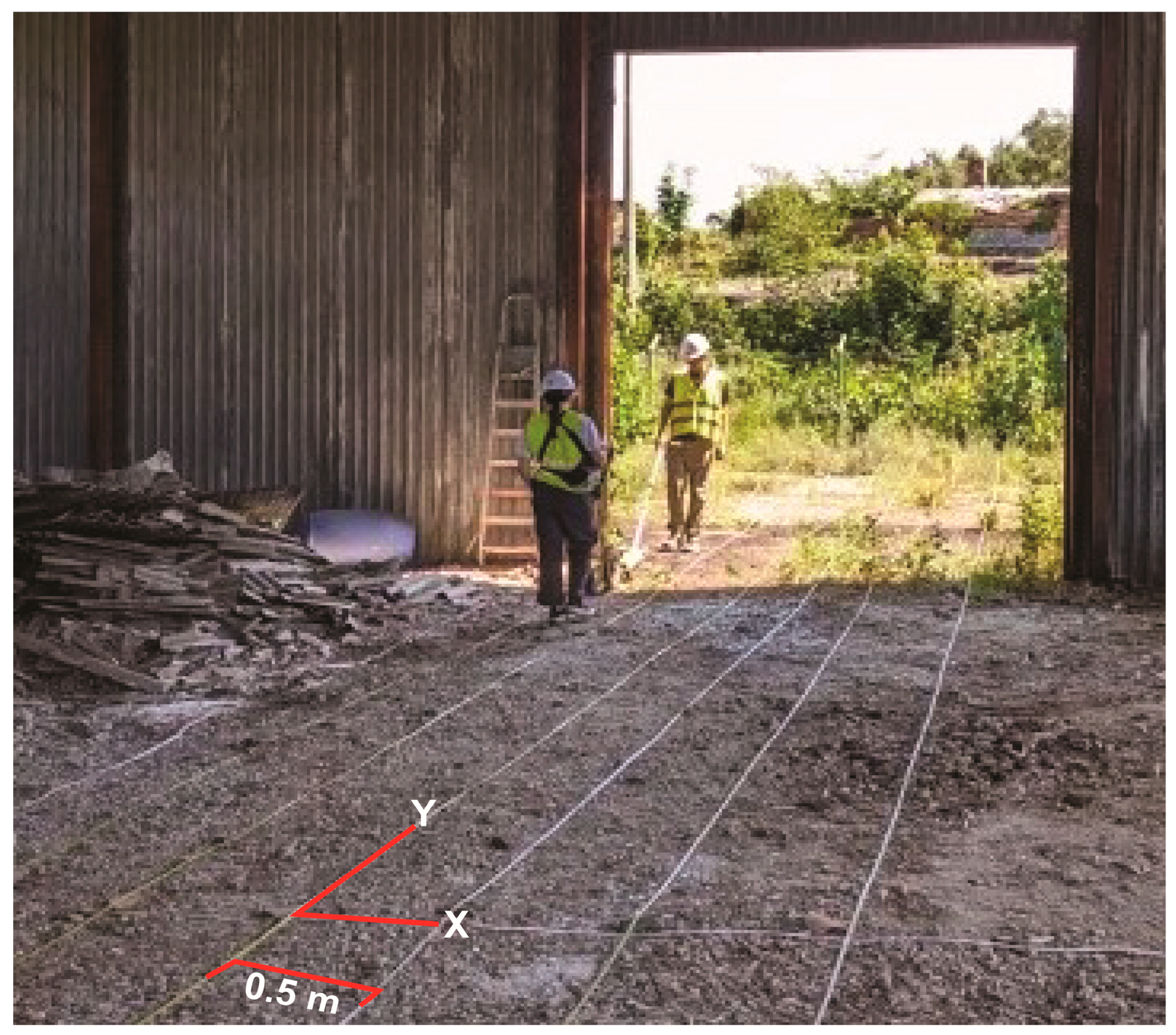
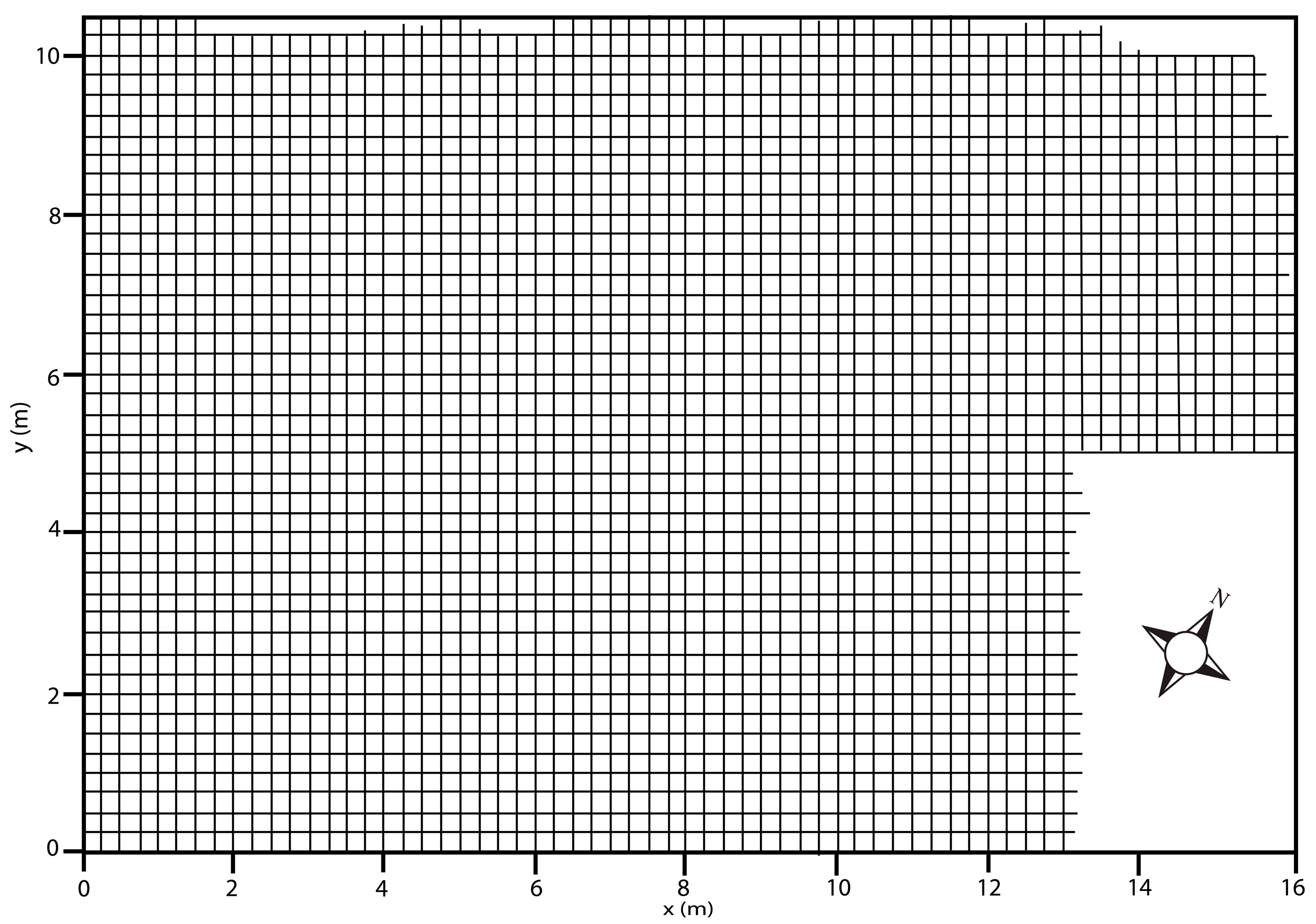

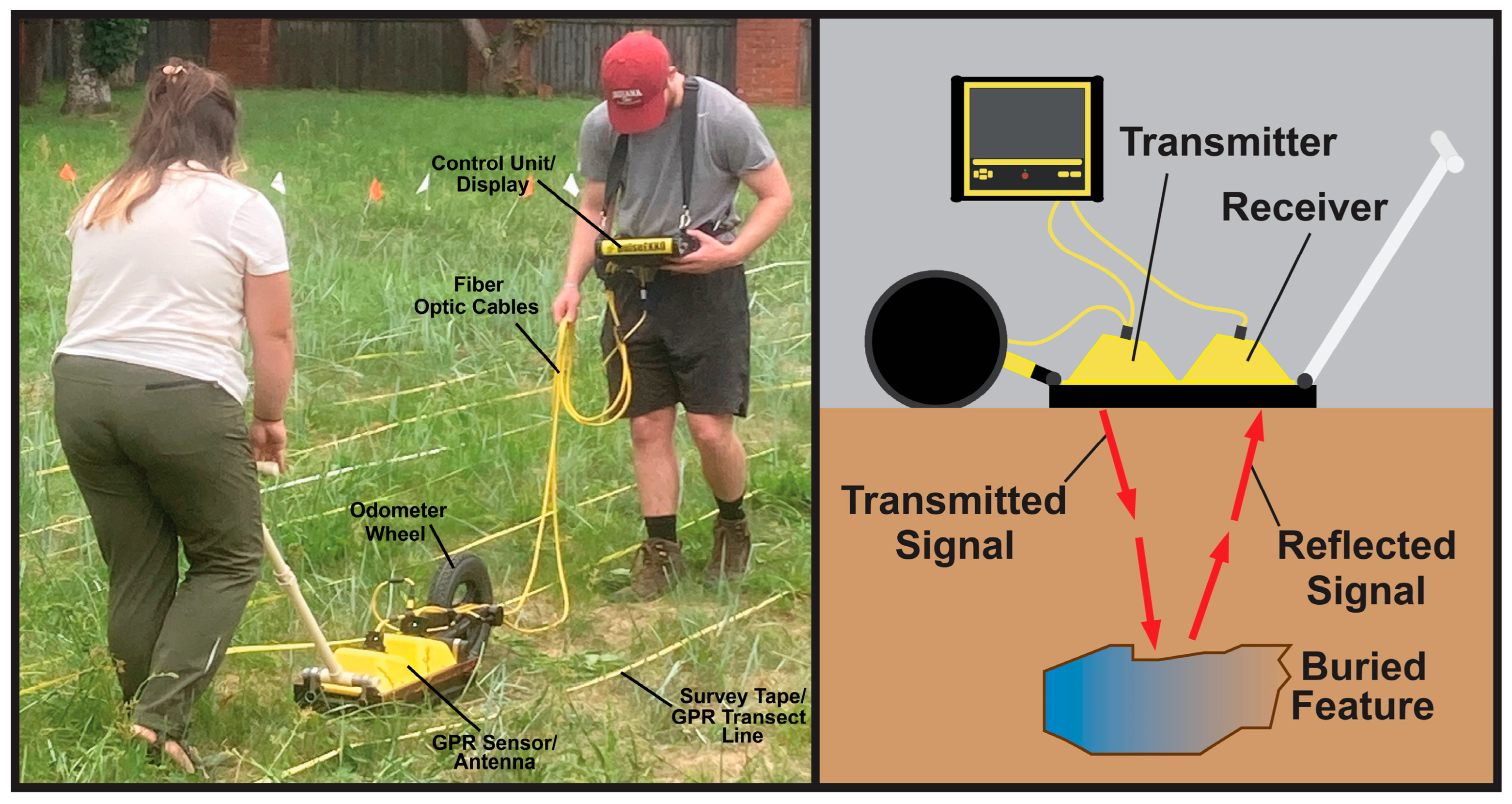

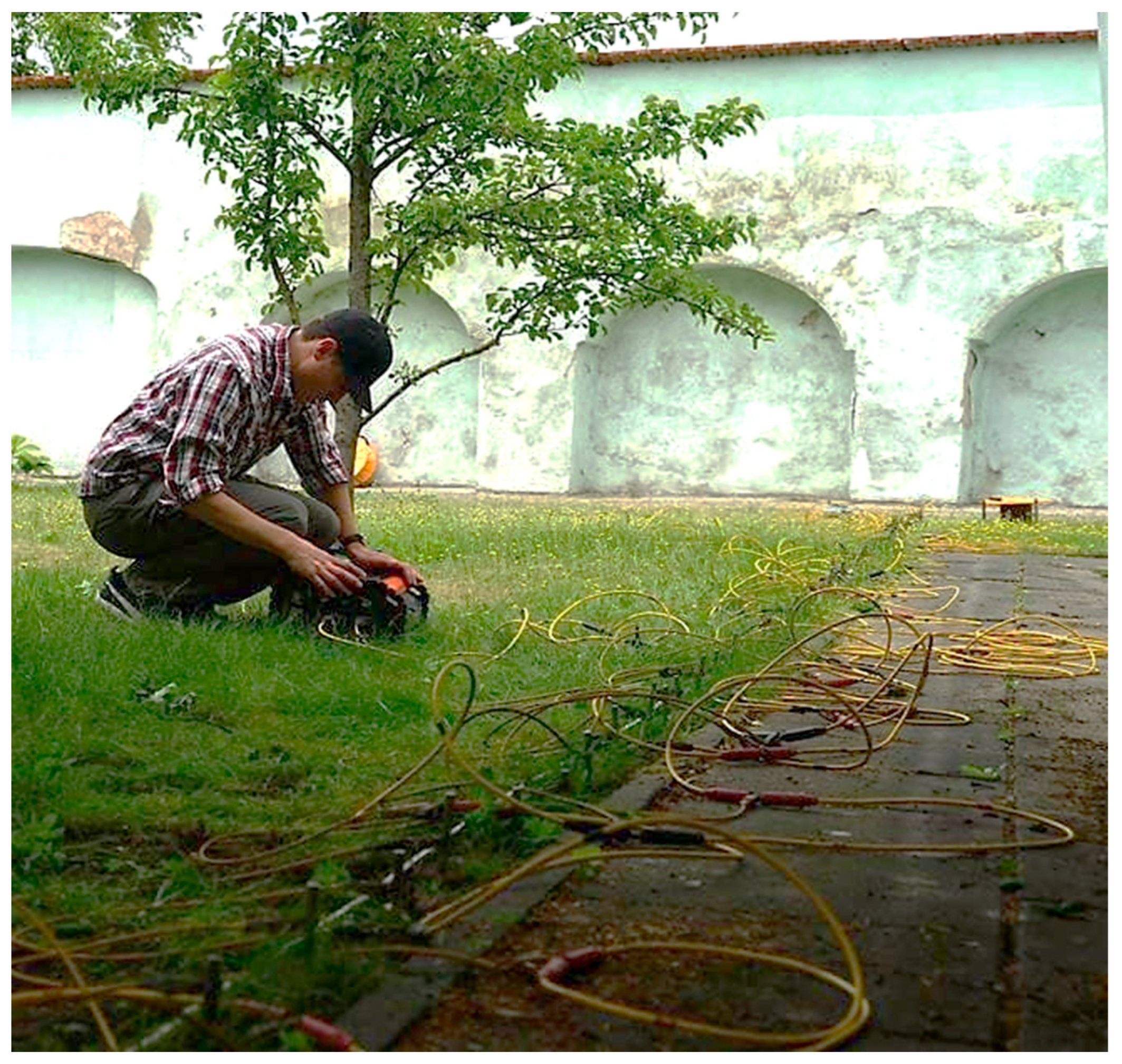
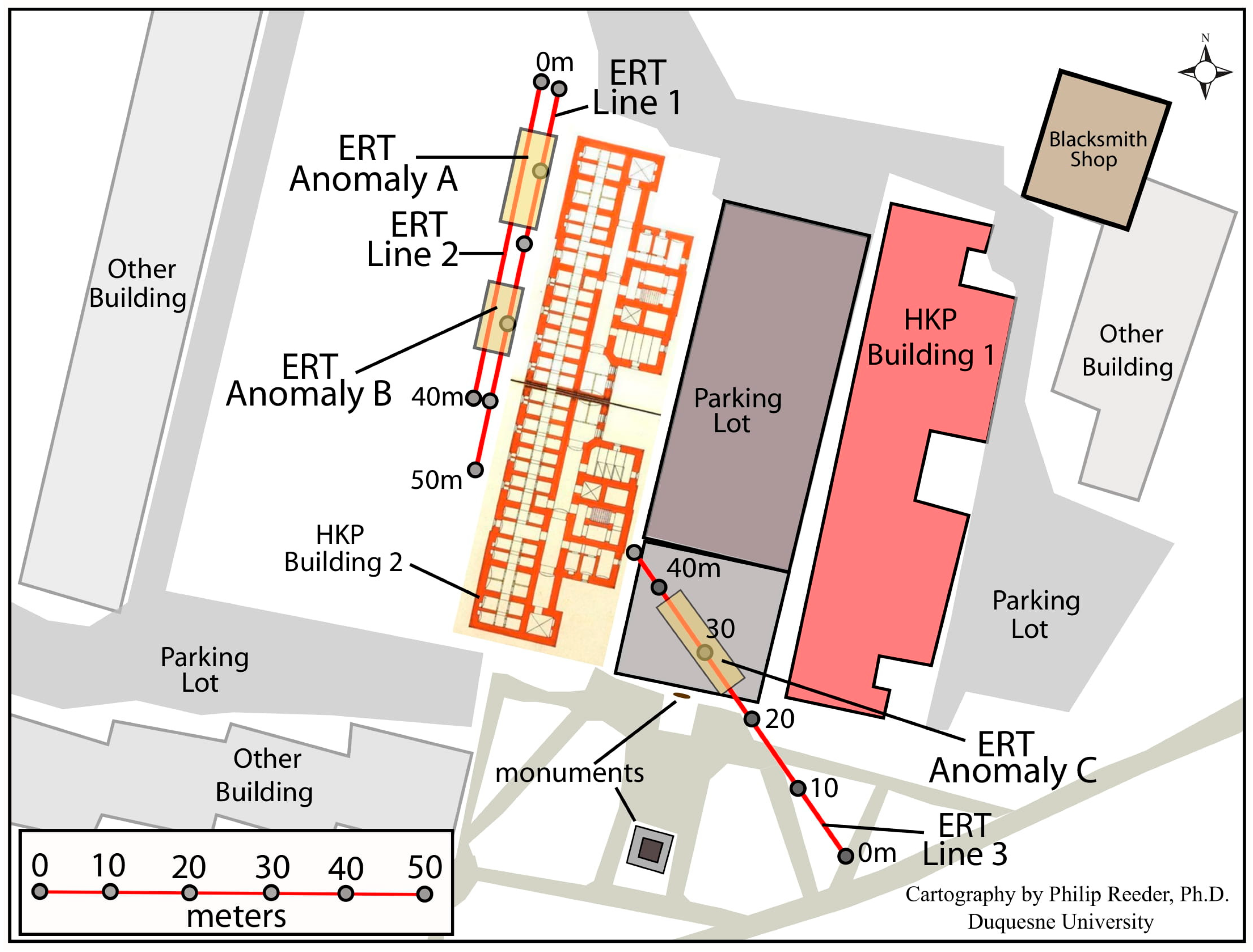


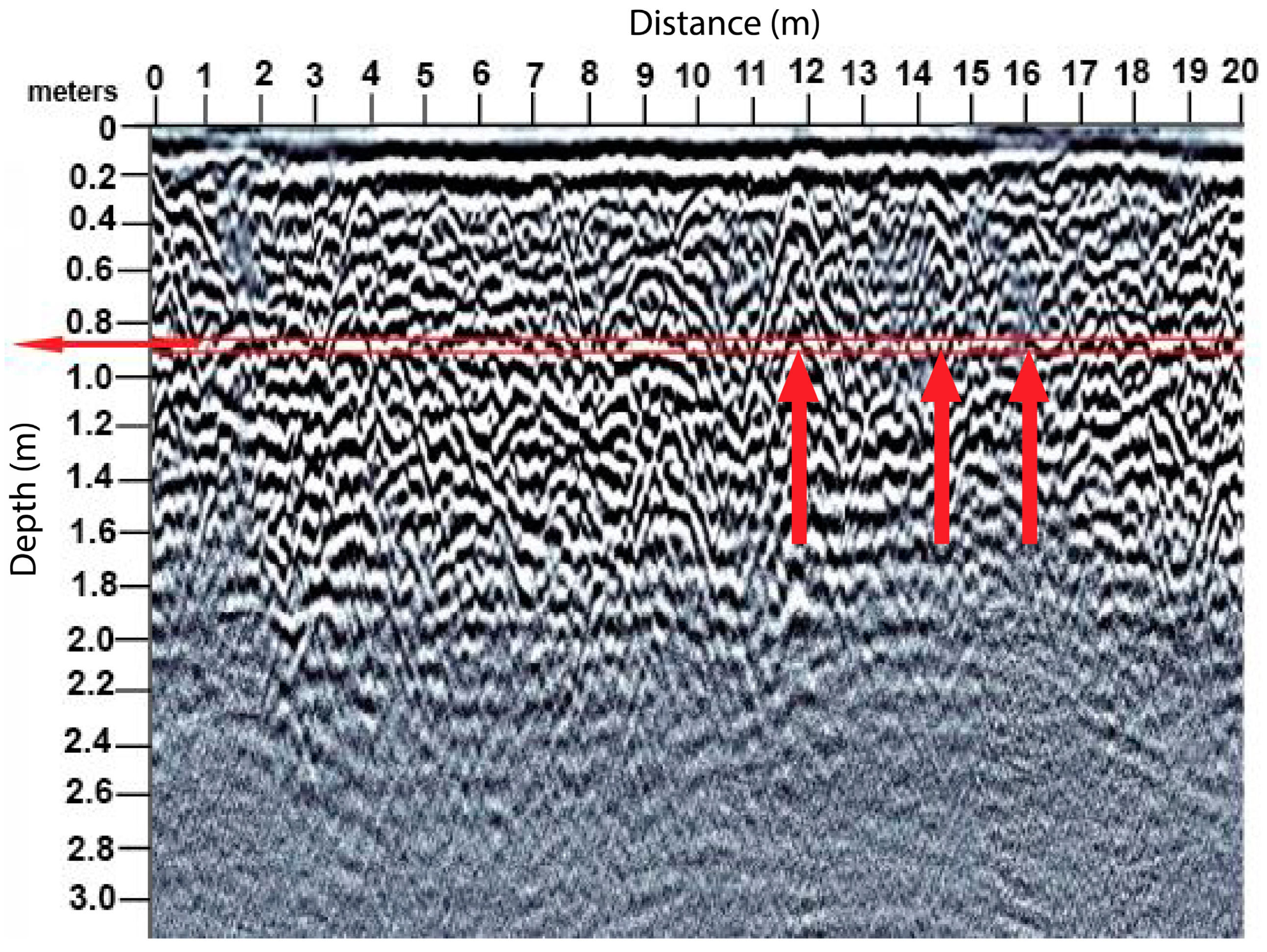

Disclaimer/Publisher’s Note: The statements, opinions and data contained in all publications are solely those of the individual author(s) and contributor(s) and not of MDPI and/or the editor(s). MDPI and/or the editor(s) disclaim responsibility for any injury to people or property resulting from any ideas, methods, instructions or products referred to in the content. |
© 2025 by the author. Licensee MDPI, Basel, Switzerland. This article is an open access article distributed under the terms and conditions of the Creative Commons Attribution (CC BY) license (https://creativecommons.org/licenses/by/4.0/).
Share and Cite
Reeder, P. Two Geophysical Technologies Used in Archaeological Research Simplified and Explained. Encyclopedia 2025, 5, 151. https://doi.org/10.3390/encyclopedia5030151
Reeder P. Two Geophysical Technologies Used in Archaeological Research Simplified and Explained. Encyclopedia. 2025; 5(3):151. https://doi.org/10.3390/encyclopedia5030151
Chicago/Turabian StyleReeder, Philip. 2025. "Two Geophysical Technologies Used in Archaeological Research Simplified and Explained" Encyclopedia 5, no. 3: 151. https://doi.org/10.3390/encyclopedia5030151
APA StyleReeder, P. (2025). Two Geophysical Technologies Used in Archaeological Research Simplified and Explained. Encyclopedia, 5(3), 151. https://doi.org/10.3390/encyclopedia5030151





